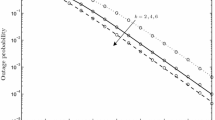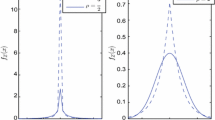Abstract
In this paper, we provide a unified analysis for wireless system over generalized fading channels that is modeled by the two parameter generalized gamma model. This model is versatile enough to represent short-term fading such as Weibull, Nakagami-m, or Rayleigh as well as shadowing. The performance measures such as the amount of fading, average bit error rate, and signal outage are considered for analysis. With the aid of moment generating function (MGF) approach and Padé approximation (PA) technique, outage probability and average bit error rate have been evaluated for a variety of modulation formats. We first use the PA technique to find a simple way to evaluate compact rational expressions for the MGF of output signal-to-noise ratio, unlike previously derived intricate expressions in terms of Fox’s H and MeijerG functions. Using these rational expressions, we evaluate the performance of wireless receivers under a range of representative channel fading conditions. Our results are validated through computer simulations, which shows perfect match.





Similar content being viewed by others
References
Simon MK, Alouini M-S (2005) Digital communication over fading channels, 2nd ed. Wiley, New York
Aalo VA, Piboongungon T, Iskander C-D (2005) Bit-error rate of binary digital modulation schemes in generalized gamma fading channels. IEEE Commun Lett 09(2):139–141
Coulson AJ, Williamson AG, Vaughan RG (1998) Improved fading distribution for mobile radio. IEE Proc F-Commun 145:197–202
Yacoub MD (2002) The α-µ distribution: a general fading distribution. Proc. IEEE PIMRC, Lisbon, Portugal, pp 629–633
Karagiannidis GK (2004) Moments-based approach to the performance analysis of equal gain diversity in Nakagami-m Fading. IEEE Trans Commun 52(5):685–690
Ismail MH, Matalgarh MM (2006) Performance of dual maximal ratio combining diversity in nonidentical correlated weibull fading channels using Padé approximation. IEEE Trans Commun 54(3):397–402
Gradshteyn IS, Ryzhik IM (1994) Table of integrals, series, and products, 5th ed. Academic, New York
Amindavar H, Ritcey JA (1994) Padé approximation of probability density functions. IEEE Trans Aerosp Electron Syst 30(2):416–424
Stokes JW, Ritcey JA (1998) A general method for evaluating outage probabilities using Padé approximations. In Proc. IEEE Global Telecommun Conf, vol 3, pp 1485–1490, Sydney, Australia, Nov
Lu J, Letaief KB, Chuang JC-I, Liou ML (1999) M-PSK and M-QAM BER computation using signal-space concepts. IEEE Trans Commun 47(2):181–184
Sagias NC, Mathiopoulos PT (2005) Switched diversity receivers over generalized gamma fading channels. IEEE Commun Lett 9:10
Yacoub MD (2007) The α-µ distribution: A physical fading model for the Stacy distribution. IEEE Trans Veh Technol 56(1):27–34
Author information
Authors and Affiliations
Corresponding author
Rights and permissions
About this article
Cite this article
Malhotra, J., Sharma, A.K. & Kaler, R.S. On the performance analysis of wireless receiver using generalized-gamma fading model. Ann. Telecommun. 64, 147–153 (2009). https://doi.org/10.1007/s12243-008-0061-2
Received:
Revised:
Accepted:
Published:
Issue Date:
DOI: https://doi.org/10.1007/s12243-008-0061-2




